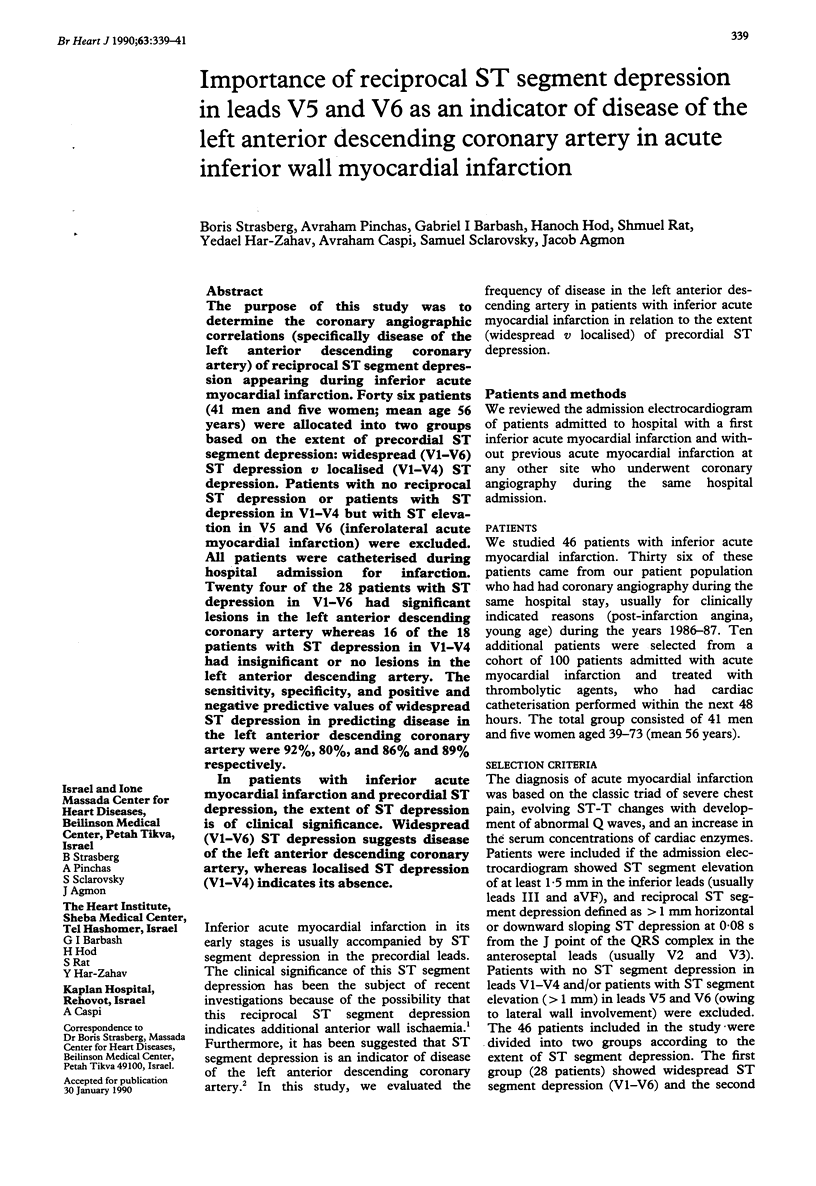Abstract
The purpose of this study was to determine the coronary angiographic correlations (specifically disease of the left anterior descending coronary artery) of reciprocal ST segment depression appearing during inferior acute myocardial infarction. Forty six patients (41 men and five women; mean age 56 years) were allocated into two groups based on the extent of precordial ST segment depression: widespread (V1-V6) ST depression v localised (V1-V4) ST depression. Patients with no reciprocal ST depression or patients with ST depression in V1-V4 but with ST elevation in V5 and V6 (inferolateral acute myocardial infarction) were excluded. All patients were catheterised during hospital admission for infarction. Twenty four of the 28 patients with ST depression in V1-V6 had significant lesions in the left anterior descending coronary artery whereas 16 of the 18 patients with ST depression in V1-V4 had insignificant or no lesions in the left anterior descending artery. The sensitivity, specificity, and positive and negative predictive values of widespread ST depression in predicting disease in the left anterior descending coronary artery were 92%, 80%, and 86% and 89% respectively. In patients with inferior acute myocardial infarction and precordial ST depression, the extent of ST depression is of clinical significance. Widespread (V1-V6) ST depression suggests disease of the left anterior descending coronary artery, whereas localised ST depression (V1-V4) indicates its absence.
Full text
PDF


Selected References
These references are in PubMed. This may not be the complete list of references from this article.
- Akhras F., Upward J., Jackson G. Reciprocal change in ST segment in acute myocardial infarction: correlation with findings on exercise electrocardiography and coronary angiography. Br Med J (Clin Res Ed) 1985 Jun 29;290(6486):1931–1934. doi: 10.1136/bmj.290.6486.1931. [DOI] [PMC free article] [PubMed] [Google Scholar]
- Billadello J. J., Smith J. L., Ludbrook P. A., Tiefenbrunn A. J., Jaffe A. S., Sobel B. E., Geltman E. M. Implications of "reciprocal" ST segment depression associated with acute myocardial infarction identified by positron tomography. J Am Coll Cardiol. 1983 Oct;2(4):616–624. doi: 10.1016/s0735-1097(83)80300-3. [DOI] [PubMed] [Google Scholar]
- Croft C. H., Woodward W., Nicod P., Corbett J. R., Lewis S. E., Willerson J. T., Rude R. E. Clinical implications of anterior S-T segment depression in patients with acute inferior myocardial infarction. Am J Cardiol. 1982 Sep;50(3):428–436. doi: 10.1016/0002-9149(82)90306-x. [DOI] [PubMed] [Google Scholar]
- Gelman J. S., Saltups A. Precordial ST segment depression in patients with inferior myocardial infarction: clinical implications. Br Heart J. 1982 Dec;48(6):560–565. doi: 10.1136/hrt.48.6.560. [DOI] [PMC free article] [PubMed] [Google Scholar]
- Gibelin P., Gilles B., Baudouy M., Guarino L., Morand P. Reciprocal ST segment changes in acute inferior myocardial infarction: clinical, haemodynamic and angiographic implications. Eur Heart J. 1986 Feb;7(2):133–139. doi: 10.1093/oxfordjournals.eurheartj.a062035. [DOI] [PubMed] [Google Scholar]
- Gibson R. S., Crampton R. S., Watson D. D., Taylor G. J., Carabello B. A., Holt N. D., Beller G. A. Precordial ST-segment depression during acute inferior myocardial infarction: clinical, scintigraphic and angiographic correlations. Circulation. 1982 Oct;66(4):732–741. doi: 10.1161/01.cir.66.4.732. [DOI] [PubMed] [Google Scholar]
- Goldberg H. L., Borer J. S., Jacobstein J. G., Kluger J., Scheidt S. S., Alonso D. R. Anterior S-T segment depression in acute inferior myocardial infarction: indicator of posterolateral infarction. Am J Cardiol. 1981 Dec;48(6):1009–1015. doi: 10.1016/0002-9149(81)90313-1. [DOI] [PubMed] [Google Scholar]
- Jennings K., Reid D. S., Julian D. G. "Reciprocal" depression of the ST segment in acute myocardial infarction. Br Med J (Clin Res Ed) 1983 Sep 3;287(6393):634–637. doi: 10.1136/bmj.287.6393.634. [DOI] [PMC free article] [PubMed] [Google Scholar]
- Lew A. S., Maddahi J., Shah P. K., Weiss A. T., Peter T., Berman D. S., Ganz W. Factors that determine the direction and magnitude of precordial ST-segment deviations during inferior wall acute myocardial infarction. Am J Cardiol. 1985 Apr 1;55(8):883–888. doi: 10.1016/0002-9149(85)90711-8. [DOI] [PubMed] [Google Scholar]
- Lew A. S., Weiss A. T., Shah P. K., Maddahi J., Peter T., Ganz W., Swan H. J., Berman D. S. Precordial ST segment depression during acute inferior myocardial infarction: early thallium-201 scintigraphic evidence of adjacent posterolateral or inferoseptal involvement. J Am Coll Cardiol. 1985 Feb;5(2 Pt 1):203–209. doi: 10.1016/s0735-1097(85)80038-3. [DOI] [PubMed] [Google Scholar]
- Ong L., Valdellon B., Coromilas J., Brody R., Reiser P., Morrison J. Precordial S-T segment depression in inferior myocardial infarction. Evaluation by quantitative thallium-201 scintigraphy and technetium-99m ventriculography. Am J Cardiol. 1983 Mar 1;51(5):734–739. doi: 10.1016/s0002-9149(83)80124-6. [DOI] [PubMed] [Google Scholar]
- Salcedo J. R., Baird M. G., Chambers R. J., Beanlands D. S. Significance of reciprocal S-T segment depression in anterior precordial leads in acute inferior myocardial infarction: concomitant left anterior descending coronary artery disease? Am J Cardiol. 1981 Dec;48(6):1003–1008. doi: 10.1016/0002-9149(81)90312-x. [DOI] [PubMed] [Google Scholar]
- Sclarovsky S., Davidson E., Lewin R. F., Strasberg B., Arditti A., Agmon J. Unstable angina pectoris evolving to acute myocardial infarction: significance of ECG changes during chest pain. Am Heart J. 1986 Sep;112(3):459–462. doi: 10.1016/0002-8703(86)90506-5. [DOI] [PubMed] [Google Scholar]
- Sclarovsky S., Topaz O., Rechavia E., Strasberg B., Agmon J. Ischemic ST segment depression in leads V2-V3 as the presenting electrocardiographic feature of posterolateral wall myocardial infarction. Am Heart J. 1987 May;113(5):1085–1090. doi: 10.1016/0002-8703(87)90916-1. [DOI] [PubMed] [Google Scholar]
- Shah P. K., Pichler M., Berman D. S., Maddahi J., Peter T., Singh B. N., Swan H. J. Noninvasive identification of a high risk subset of patients with acute inferior myocardial infarction. Am J Cardiol. 1980 Dec 1;46(6):915–921. doi: 10.1016/0002-9149(80)90345-8. [DOI] [PubMed] [Google Scholar]
- Wasserman A. G., Ross A. M., Bogaty D., Richardson D. W., Hutchinson R. G., Rios J. C. Anterior ST segment depression during acute inferior myocardial infarction: evidence for the reciprocal change theory. Am Heart J. 1983 Sep;106(3):516–520. doi: 10.1016/0002-8703(83)90695-6. [DOI] [PubMed] [Google Scholar]


